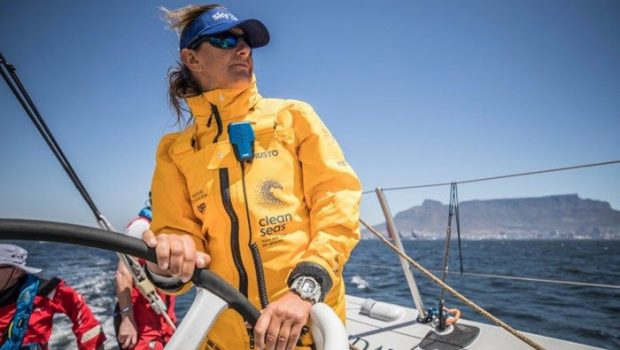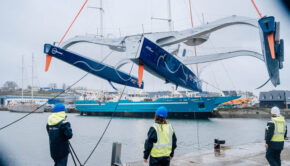Gender Diversity in Sailing
Published on May 9th, 2019
Dee Caffari (GBR) knows all about the challenges it takes to get to the top in the sporting world. She has sailed around the world six times, was the first woman to sail single-handed and non-stop around the world in both directions and is still the only woman to have sailed non-stop around the world three times.
A former PE teacher, she came to professional sailing relatively late aged 27 having dabbled with the sport at university and didn’t follow the typical sailing club or national performance pathways.
Dee found sailing and opportunity found Dee, and as is often the case with adventurers and record-breakers, it was a mix of natural talent, dogged determination, and a streak of stubbornness all mixed with a dose of luck that put her on the road to top level sporting success.
The World Sailing Trust, of which Dee is chair, has received funding from entrepreneur and businessman Andrew Pindar to fund research to explore gender diversity in the sport of sailing across a number of areas – from grass roots and leisure sailing right through to high level competition.
The objective is to shed some light on why exactly it is that there are less women in the sport and what obstacles there are to their participation. Dee shares her thoughts on the topic for The Mallory Group, a marketing and advertising agency that specializes in sports partnerships for brands and rights holders:
Gender diversity in sport continues to be a hot topic, with new campaigns or initiatives to promote or encourage greater opportunities being regularly introduced in all areas of the sporting world.
Sailing, like many other sports, is not immune to gender disparity. The World Sailing Trust have recognized this and are investing in research to discover the reasons behind it and gain a greater understanding of what can be achieved to improve this moving forward.
Whilst there is a relatively even split between male and female competitors in Olympic sailing, this is not mirrored behind the scenes in roles such as coaching or race officials working in this environment. World Sailing’s goal is to improve diversity by 2024 so that there is a more even gender split.
However, in order to achieve this, action needs to begin now to ensure that the relevant training opportunities are available for women to acquire the skills and experience needed to support the roles available.
The research being undertaken by the World Sailing Trust will explore gender diversity in the sport of sailing across a number of areas – from grass roots and leisure sailing right through to high level competition. The objective is to shed some light on why exactly it is that there are less women and what obstacles there are to their participation.
Sailing is not unique in its struggle to attract and retain females.
In the early years, there is a greater balance of gender participation and this is largely down to parental influence or family membership of sailing clubs. At this stage, it is a leisure pursuit that the whole family are involved in and there are less distractions to lure young people away.
Fast forward a few years to the teens and, as with many other sports, there is a sharp drop off in numbers as sport competes with a number of other extra-curricular activities. While the teenage drop off translates to girls and boys alike, it is significantly worse in girls and they are less likely to be enticed back later in life.
I have noticed that Cowes Week and RORC sailing have many females onboard when it comes to racing but this is not reflected in more elite racing circles or the support network around sailing athletes, which still remains male dominated.
The coaching role is an interesting one to explore as many female sports teams have male coaches. Typically this will be due to a male coach bringing racing experience to the table and being perceived as more suited to that role as a result. This does beg the question though – do you need to be a former athlete to be a good coach and get the best out of people or do you just need to have good coaching skills?
In my experience, professional race crew skippers tend to select people they know and trust or sailors that come recommended by people they know and trust. This makes it incredibly difficult for even the most talented of sailors to infiltrate this world because, whether you are male or female, it is often the connection that gets you a foot in the door which then enables you to prove yourself. Without breaking this nepotistic culture, the cycle will inevitably continue, and a wealth of talent potentially overlooked.
Another factor I anticipate the research will reveal is that coaching and race official roles are often unpaid or part time and therefore attract participants who have spare time and/or not reliant on the income generated. Individuals with familial responsibilities who depend on regular guaranteed income may not be in a position to consider these roles as they are untenable.
I firmly believe that if we can see it, we can be it, and this is why we must have role models. Seeing females in action will give the next generation something tangible to aspire to and enable them to set goals for their own career path.
The Olympics shows how successful role modelling is. With exposure to mainstream audiences and good development pathways, sailing in the Olympics is seen as something that is possible to achieve provided you have the drive and commitment.
Sadly, at this point in time, offshore sailing lacks the same level of structure or grass roots investment. In other sports, such as football or hockey for example, talent scouts regularly visit junior clubs across the UK to identity future talent from an early age and put them on the path of more intensive training.
Again, this simply doesn’t happen in offshore sailing and it is word of mouth and personal recommendations that lead to opportunities.
We have to also be realistic and accept that roles around competitive sailing are likely to be seasonal unless you are happy to live a rather nomadic lifestyle and follow the action around the globe. In that respect, we need to consider whether the issue is actually a lack of female sailors being given opportunities or if there is in fact a lack of female sailors who want to take on those roles. We can create demand but roles will only ever be filled by people willing to take them on.
Follow Dee on Twitter @deecaffari









 We’ll keep your information safe.
We’ll keep your information safe.